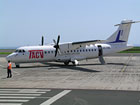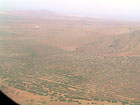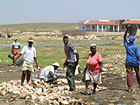

 | |||||||||||||||||||||
|
|
Journals 2006/2007Mike Lampert
October 6, 2006 On Friday morning we have a quick breakfast with great mango juice. Prof. Hedlin tells me I am not supposed to drink the tap water, but I have been doing that all along (it tastes ten times better than San Diego tap water!). We meet two of the project engineers at the Tropico before leaving to the airport. Both are local to the main city of Praia and were responsible for securing the permit to build the infrasound array on Maio. Apparently the site is all on government protected land in the middle of an Acacia forest that has been planted to restore the island to its natural state. It is experimental, with the hope to duplicate it on the other islands. Infrasound detection is very sensitive to wind noise and the trees filter this. They take us to the airport. I like very much the African influence at the hotel, lots of reds and browns, carved wood and rattan. Despite the dusty environment the people wear clean and colorful clothes and are extremely friendly. The airport at Praia is new. There is no security at all really, though you still have to go through un-powered detectors for whatever reason. I quickly change my money to Escudos, roughly 100CVE make a dollar. The paper bills are really well worn, soft and dirty. The flight leaves roughly at 11 AM. It is a full flight for just twenty minutes, an island hop by a small propeller jet. In the air I can see the island of Maio below, it has distinct rows of trees and appears flat mostly except for a mountain region to the north-east. It is all of about 10 by 20 km across, about as big as the town of Salem where I come from. Everyone applauds when we land apparently it is a tradition here. The airport at Maio is very small and reminds me of the old train stations along the Pacific coast. There is one desk, a baggage room, a gift shop and a small W.C. We wait a long time for our baggage. Two policeman stand guard at the exit to keep people from coming in to greet travelers, the order goes away quickly as the suitcases are dispensed one at a time. Our long wait invites conversation with Christina. She is here from Chicago doing her Fulbright on international theater, particularly Cape Verde Theater and how the culture is integrated into the plays.
Enrique meets us to take us out to the site. He is the head contractor who has hired eight laborers to help out at the site. He is driving an old Daihatsu and it is empty of gas. We head into town to get another truck and fill up. Prof Hedlin drives though he is a bit big for the truck seat. He has carried, all the way from San Diego, an expensive GPS system capable of measuring distances down to one centimeter. The site is about 4 km away over a road made of basalt type rock quarried into cobblestones. Each stone is laid by hand. My eyes immediately set upon the road construction. The locals are man-hauling the rock in baskets over their heads, very much like I have only seen in pictures.
The town is a mix of old (very old) and brand new. The run down appearance of the outsides belies the cleanliness of the inside of the homes. It is about 1 pm and we make the turn up a dusty road. Another kilometer and we meet the crew coming into town for lunch. Don, Clint, Eric and Joel are sweating like dirt rats. It is very hot in the interior of the island where the trees break the coastal wind. We join them and head back into town. They have been here since the middle of September and have made remarkable progress. They have taken four large sea containers of equipment and moved them into the forest. They have set-up a good portion of the piping for the array. We eat at a small Italian place. Paulo is the chef and he clearly has a passion for dining. He lays a colorful table cloth out and explains the menu. Life here is completely different then the states. We drink lots of bottled water, have grilled tuna with green beans. The local pan handler comes by, unfortunately he is mentally ill and talks gibberish. A local comes over and gently shoes him away. It is all new for me but for the rest it is normal. We head out to the array again. The only store with water is closed but I still have water from Praia. We pass through a small town. I see the school children dressed perfectly with back packs going off to school. At the array we get right at it. Prof. Hedlin brought gloves for everyone. The pipes needed to be fit. It is a tough sweaty job. We break into teams. We work till 7pm to get one site finished. There are three sites in the middles and five on the outside. Each site is like 8 bicycle wheels laid out on the ground in circles. Each wheel with 18 spokes. So that is 144 pipes with all the fittings to be secured. Plus there are eight total sites, well over a thousand pipes! Wow! They hope to finish setting pipes for the last two sites tomorrow.
At the end of the day a full moon rises. I am drenched in sweat. Clint pressure tests the array. It is holding steady. They must report back to the people who certify the site. The lead inspector is coming on Monday. As we were working the local kids came by, one was on a donkey, and I am so sorry I missed that photo! We dump all the equipment in a locked container and drive back in the dark nearly knocking some cows over in the road. The first town is dark. I realize I take electricity for granted. The people sit outside in the cool breeze and moon light. I am staying at a small 4-story hotel named Marilu. It is very clean. The people are nice, they had expected me earlier but they are ok I am late as the hotel is hardly full. We have dinner at the Tutti Fruitti, a pizza Italian place. I have a thin crust cheese pizza. Very good food. The atmosphere is open door, clean, a waitress and a home-cooked meal. Don is apart from the group preferring one place only. The town is still bustling with kids playing in the street and people hanging out on the sea wall. Tomorrow it is up at six to work again. Sunday is the day off. As I write this the power to the town goes out. |
||||||||||||||||||||




